Tom Parkinson's monthly column, introducing the diverse range of flora and fauna on show at Sanctuary Lakes.
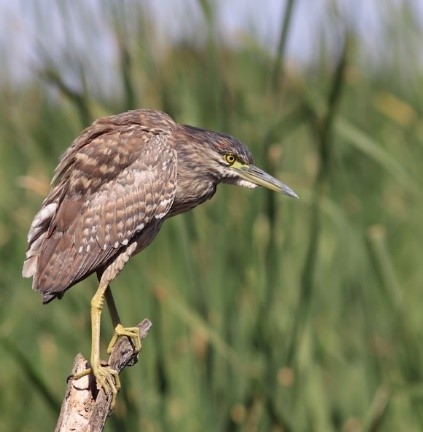 Juvenile Nankeen Night Heron caledonicus A few weeks back, Sanctuary Lakes resident James contacted me about a "mystery bird" he had seen one evening, while walking his dogs by the Grand Canal. His description was "it looks like a long legged larger kookaburra, well camouflaged against the muddy canal waters, being entirely brown with an even distribution of mottled black feathers coming through. It looks like an ambush predator, like a heron, but it's fatter than a heron and not so timid. When I go past with my dogs it simply walks along the blue boom barrier into the middle of the canal." A couple of nights, later I viewed this 'mystery bird'. After a telephone discussion with bird expert Bob Winters, we concluded that this mystery bird was a juvenile Nankeen Night Heron. As can be seen in the photos below the strangeness comes from the fact that the juvenile has a totally different colouring to the adult Nankeen. By coincidence the following morning I spotted two pairs of magnificent Great White Egrets adding further to the other visiting variety of Herons and Egrets on Sanctuary Lake and ponds.
Juvenile Nankeen Night Heron caledonicus A few weeks back, Sanctuary Lakes resident James contacted me about a "mystery bird" he had seen one evening, while walking his dogs by the Grand Canal. His description was "it looks like a long legged larger kookaburra, well camouflaged against the muddy canal waters, being entirely brown with an even distribution of mottled black feathers coming through. It looks like an ambush predator, like a heron, but it's fatter than a heron and not so timid. When I go past with my dogs it simply walks along the blue boom barrier into the middle of the canal." A couple of nights, later I viewed this 'mystery bird'. After a telephone discussion with bird expert Bob Winters, we concluded that this mystery bird was a juvenile Nankeen Night Heron. As can be seen in the photos below the strangeness comes from the fact that the juvenile has a totally different colouring to the adult Nankeen. By coincidence the following morning I spotted two pairs of magnificent Great White Egrets adding further to the other visiting variety of Herons and Egrets on Sanctuary Lake and ponds.
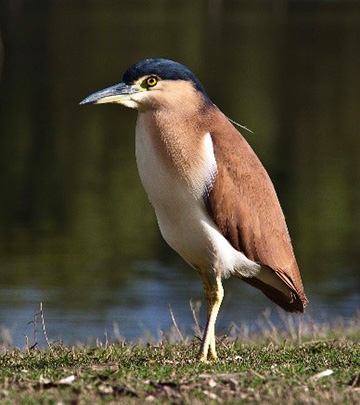 Adult Nankeen Night Heron Nycticorax Herons and Egrets are from the same family, so what is the difference? The name Egret comes from the French "aigrette" meaning white plume feathers. For many years they were popular in the fashion trade. Egrets were the Herons from which "aigrettes" were obtained. The term has since lost its original meaning and is now simply describes the white feathered members of the Heron family.
Adult Nankeen Night Heron Nycticorax Herons and Egrets are from the same family, so what is the difference? The name Egret comes from the French "aigrette" meaning white plume feathers. For many years they were popular in the fashion trade. Egrets were the Herons from which "aigrettes" were obtained. The term has since lost its original meaning and is now simply describes the white feathered members of the Heron family.
James' mystery bird, the Nankeen Night Heron Nycticorax caledonicus is also called the Rufous Night Heron. The juvenile birds are just like James’s description, well camouflaged heavily spotted with streaks of white, brown and orange-brown. As the Nankeen mature, the black cap of the adult develops first, with the body plumage slowly changing to the adult's rich cinnamon brown with white buff under parts. Nankeen Night Herons feed primarily at night in shallow water on a wide variety of insects, crustaceans, fish and amphibians. The Nankeen is relatively common in our area, but spends much of the day roosting hidden either among dense foliage or deep beneath wharfs and bridges, only emerging in the twilight, making it generally under-reported. Like all Herons and Egrets, they breed throughout the year when rainfall and food conditions are right. A normal clutch is three to four, with both male and female incubating the eggs.
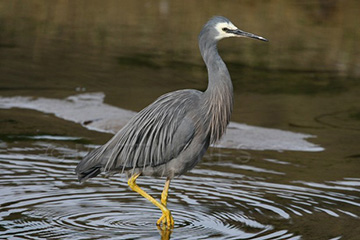 White Faced Heron Egretta novaehollandiae The White Faced Heron is the most commonly observed Heron in Sanctuary Lakes and its surrounds. They can be seen on the fringe of the Lake and Ponds foraging for a wide range of prey, mostly small aquatic creatures, using various methods, including standing and waiting for their prey, slowly stalking it, frantically dashing after it, or disturbing it by stirring the water with their feet.
White Faced Heron Egretta novaehollandiae The White Faced Heron is the most commonly observed Heron in Sanctuary Lakes and its surrounds. They can be seen on the fringe of the Lake and Ponds foraging for a wide range of prey, mostly small aquatic creatures, using various methods, including standing and waiting for their prey, slowly stalking it, frantically dashing after it, or disturbing it by stirring the water with their feet.
The White Faced Heron is mostly light blue-grey in colour, with a characteristic white face, long, slim neck and a pointed grey-black bill. The legs are long and dull yellow in colour. When breeding, the birds have long feathers (nuptial plumes) on the head, neck and back. It is a slender and graceful bird with a distinctive flight, slow and deep with bowed wings creating a rhythmic down beat.
Breeding generally takes place in September to November, but again like the other Herons and Egrets they may breed at other times in response to rainfall and food availability. Both sexes share the task of building the nest, incubating the four to five eggs and caring for the young.
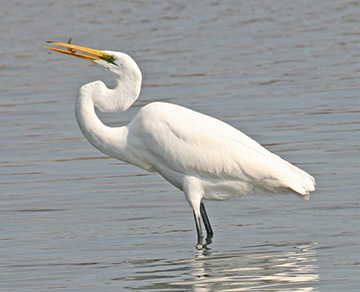 Great Egret Ardea alba intermedia In Victoria there are four main white Egrets, the Great, the Intermediate, the Cattle and the Little. Of these the most common and regular visitors to Sanctuary Lakes is the Great and the Intermediate. Both have very similar pure white colouring but the most obvious and easily observable difference is their size. The Great standing with neck stretched at 1.4 metres and a wing span of 1.7 metres and the Intermediate fully stretched is only half the size at 72cm with a wing span of one metre. The Great has a noticeable kink near the middle of its neck, and the top of its longer bill nearly aligns with the flat top of its head. Close up, the bare skin of the Great's gape line extends in a dagger shape behind the eye, while the Intermediate's is less pointed and ends below the eye. The Intermediate tends to stalk upright with neck extended forward. The Great is more patient, often adopting a sideways-leaning "one-eyed" stance.
Great Egret Ardea alba intermedia In Victoria there are four main white Egrets, the Great, the Intermediate, the Cattle and the Little. Of these the most common and regular visitors to Sanctuary Lakes is the Great and the Intermediate. Both have very similar pure white colouring but the most obvious and easily observable difference is their size. The Great standing with neck stretched at 1.4 metres and a wing span of 1.7 metres and the Intermediate fully stretched is only half the size at 72cm with a wing span of one metre. The Great has a noticeable kink near the middle of its neck, and the top of its longer bill nearly aligns with the flat top of its head. Close up, the bare skin of the Great's gape line extends in a dagger shape behind the eye, while the Intermediate's is less pointed and ends below the eye. The Intermediate tends to stalk upright with neck extended forward. The Great is more patient, often adopting a sideways-leaning "one-eyed" stance.
Both Egrets have a wondrous sophisticated controlled movements as you watch them almost in slow motion take off into flight, gracefully flying with the wind currents and outstretching the giant white wings to gently land. Without doubt Australia’s most elegant of birds, their snowy-white silhouettes so often seen wading around the fringes of our lake and ponds. They usually feed in shallow water, standing and waiting for fish, frogs, insects and other small aquatic creatures to appear before stabbing them with their long, yellow bill. They also walk slowly through the water, on the lookout for prey.
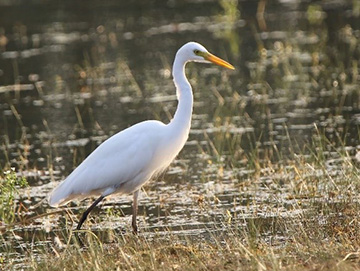 Intermediate Egret Ardea Both the Great and the Intermediate breeding patterns are similar in many ways both begin to breed at 2-3 years of age by forming monogamous pairs each season. The Great tends to nest in small colonies and the Intermediate in relative isolation. The nest is made of sticks and lined with plant material. The Great will lay up to six bluish green eggs at one time, while the Intermediate generally lays three to four eggs. Both sexes incubate the eggs and the incubation period is 23-26 days. The young are fed by regurgitation by both parents, either onto the nest or directly into the beak of the young. Both Great and Intermediate are successful breeders with over 90% able to fly from the nest within 6-7 weeks.
Intermediate Egret Ardea Both the Great and the Intermediate breeding patterns are similar in many ways both begin to breed at 2-3 years of age by forming monogamous pairs each season. The Great tends to nest in small colonies and the Intermediate in relative isolation. The nest is made of sticks and lined with plant material. The Great will lay up to six bluish green eggs at one time, while the Intermediate generally lays three to four eggs. Both sexes incubate the eggs and the incubation period is 23-26 days. The young are fed by regurgitation by both parents, either onto the nest or directly into the beak of the young. Both Great and Intermediate are successful breeders with over 90% able to fly from the nest within 6-7 weeks.
Thanks in the main to our healthy Lake and Ponds which are presently abounding with life, the Herons and Egrets appear, due to their regularly foraging for food on their shores, to be nesting close by. Without doubt, their elegant presence gives the Sanctuary Lakes neighbourhood an added sophistication.